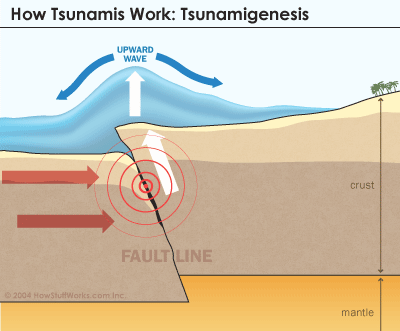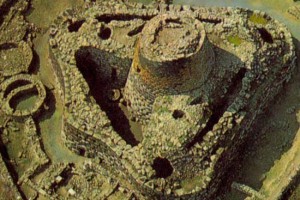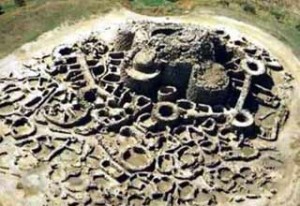Campidano
Tsunami
A Tsunami was probably first described in the 5th century BC by Thucydides when he wrote “in my opinion, the cause of the phenomenon wa s this: where the earthquake was most violent, the sea receded and was then pushed back with even greater violence, thus bringing about a flood. Such a thing would not have happened without an earthquake” (Peloponnesian War, Book III.89)(b). However, there are also conditions that can produce tsunamis inland, such as occurred around 500 AD inundating Geneva in the Alps(k)(m).
s this: where the earthquake was most violent, the sea receded and was then pushed back with even greater violence, thus bringing about a flood. Such a thing would not have happened without an earthquake” (Peloponnesian War, Book III.89)(b). However, there are also conditions that can produce tsunamis inland, such as occurred around 500 AD inundating Geneva in the Alps(k)(m).
The word ‘tsunami’ first appeared in an English language publication in the September 1896 edition of National Geographic Magazine in which the devastation caused by an earthquake wave in Japan was graphically described.
Recent studies(g) indicate that a similar tsunami saved the Greek town of Nea Poteidaia from a Persian attack in 479 BC. Herodotus in reporting the event attributed the Persian defeat to divine intervention by Poseidon, god of the sea.
A similar event on an even greater scale has been one of the suggestions as the possible cause of the flooding of Atlantis. A 2002 paper(a), by Louisiana State University geologist, Gary Byerly and his team, identified an ancient asteroid impact that generated a tsunami that “swept around the earth several times, inundating everything except the mountains”. The study of ancient tsunamis is at a very early stage of development.
A 2019 report was published online in 2022 in which it was revealed that the Yucatan asteroid impact credited with wiping out the dinosaurs 65 million years ago generated mile-high tsunamis that travelled halfway around the world. One wave was estimated to have been 1.8 miles high(ae).
Ivan T. Sanderson in one of his books, Investigating the Unexplained [768], recounts an 1863 report of a 200-foot high tsunami that sped up the Ganges and Houghli Rivers in India killing tens of thousands of people without ‘snapping-off’ trees. He contrasts this with the tree stumps covering acres around East Creek, New Jersey that have all been broken off at the same height and where he suggested that only a tsunami could have caused such widespread and uniform destruction. In view of the fact that some of these cedar trees had six-foot diameter trunks, he speculates on the possible size of a tsunami that could bring about such extreme damage.
Perhaps even more relevant to the study of Atlantis is the evidence gathered by Jürgen Spanuth in his chapter on the ‘Natural Catastrophes of the 13th Century’ including an interesting section on tsunamis [015.167].
Marc-André Gutscher of the University of Western Brittany in Plouzané, France, has discovered evidence of an ancient tsunami on Spartel Island, an Atlantis candidate, in the Gulf of Cadiz. Georgeos Diaz-Montexano has pointed out that Josephus, the 1st-century Jewish historian, seems to describe the devastation caused by its assault on the Atlantic coast of Spain and Portugal at the time of the Lusitanians and Cantabrians in the 1st millennium BC.
>Some years ago, Richard Freund, a professor from the University of Hartford, expressed support for the Donana Marshes of Southern Spain as the location of Atlantis, he attributed the swamping of the locality and the submergence of Atlantis to the power of a tsunami(ah). In 2003, Werner Wickboldt claimed that following an examination of satellite photos of Doñana, he detected structures that very closely resemble those, which Plato described in Atlantis. Freund, claims to have led a team to study the area and has had work included in a March 2011 National Geographic documentary, Finding Atlantis. However, Spanish anthropologist Juan Villarias-Robles who has worked on the site for some years has declared that Freund did not lead the investigations on the site and in fact spent less than a week there. Wickboldt’s images turned out to be either smaller than expected or were from the Muslim period. Evidence for Atlantis (or Tartessos) has not been found there.<
In the late 1970s, Booth & Fitch suggested in Earthshock[1295] that tsunamis may have been responsible for the devastation of Atlantis, an idea that has gained in popularity.
Sergio Frau has postulated that the Atlantean civilisation on Sardinia was destroyed by a tsunami.
Professor Stefano Tinti of Bologna University visited Sardinia and explained(r) “that until the 1980s no one was aware that tidal waves had occurred in the Mediterranean. But since 2004 scientists have identified 350 events of this type over a 2,500-year period,” and regarding the Sardinian tsunami “So what would have been required in our case?” he then asked. “We’re talking about a huge volume of water, some 500 metres high [the elevation up to which the nuraghi were affected]. Only a comet could do that if the impact occurred very close to the coast and in a very specific direction,” he asserted. An event of this sort may have occurred near Cagliari, with the resulting wave devastating the plain of Campidano.”
Tinti has also noted(w) that generally speaking, the majority of tsunamis are generated by seismic rather than volcanic activity. Globally, volcanic tsunamis account for only 2% of the total, however, the profusion of volcanoes in Southern Italy has considerably increased this percentage. Furthermore, according to a recent article on the BBC website “The scale of the tsunami hazard from volcanoes that collapse into the sea has been underestimated.”(x)
A 2022 report of a recent study(ac) revealed some new interesting information.
“Archaeologists have found evidence of the largest known earthquake in human history — a terrifying magnitude-9.5 megaquake that caused a 5,000-mile-long (8,000 kilometres) tsunami and prompted human populations to abandon nearby coastlines for 1,000 years.
The earthquake struck about 3,800 years ago in what is now northern Chile when a tectonic plate rupture lifted the region’s coastline. The subsequent tsunami was so powerful, it created waves as high as 66 feet (20 meters) and travelled all the way to New Zealand, where it hurled car-size boulders hundreds of miles inland, the researchers found.”
More recently, Dhani Irwanto has written about the probable effect of tsunamis on his Indonesian Atlantis(y). Studies of the sedimentary record in a sea cave in Sumatra have revealed the frequency and strength of tsunamis in the region over a five-thousand-year span from 5900 BC until 900 BC(u).
Tsunamis are also associated with the destruction on Crete following the eruption of Thera in the 2nd millennium BC. A TV documentary entitled Sinking Atlantis(i), provided graphic evidence of tsunami damage on Minoan Crete(h).
J.V.Luce cited[120.119] a number of local legends from around the Aegean that may have originated with the tsunami that followed the eruption on Thera.
However, the extent of this damage is strongly contested by W. Sheppard Baird(j) and he proposes instead that it was in fact more likely to have been a pyroclastic surge from the Theran eruption that caused the most damage.
A recent report(d) concludes that a large tsunami generated by the volcanic activity of Mt. Etna around 6000 BC produced waves up to 43 feet high that struck the coasts of Greece and Libya. This event would have caused devastation on nearby Malta, where evidence of past tsunamis was published in the journal Zeitschrift für Geomorphologie. The research was carried out over three years by scientists from the University of Portsmouth, led by Dr Malcolm Bray with assistance from colleagues at the Department of Geography at the University of Malta(n). A 1693 earthquake generated the earliest recorded tsunami on Malta and as recent as 1908 Malta was hit by a tsunami that resulted from a catastrophic earthquake in the vicinity of the Strait of Messina(p).
On the Atlantic west coast of Ireland, we have a 250 km2 region, in County Clare, known as the Burren, which consists of limestone denuded of soil cover. Recently, strong evidence was discovered suggesting a 4000 BC tsunami in the region(o). For me, the karst landscape of the Burren is reminiscent of parts of Malta.
Plato’s description does not support the idea of a tsunami as the primary cause of Atlantis’ inundation since tsunamis will eventually subside and return to the ocean, whereas Atlantis was still underwater centuries after the event, causing a permanent navigation hazard. John Michael Greer makes a similar point [345.126] in relation to the megatsunami which struck Madagascar in 2800 BC. Evidence of other ancient megatsunamis in Hawaii was presented at the 2012 meeting of the American Geophysical Union(l). The power of megatsunamis is highlighted in an article on the UK’s MailOnline website(t). Atlantisforschung also offers a lengthy article about megatsunamis(af).
Recent excavations at Olympia on the Peloponnese peninsula, the location of the original Olympic Games, have pointed to the site having been repeatedly hit by devastating tsunamis during the past 7,000 years(c).
The Bunurong tribe in Australia has a ‘myth’ that explains the creation of Melbourne’s Port Philip Bay. A recent article(e) has linked this to a tsunami that resulted from the impact of Comet Manhuika southwest of New Zealand in the 15th century. A more cautious view of this event is expressed elsewhere(f).
The excellent livescience.com website has an interesting list of ten history-making tsunamis(q), while Wikipedia offers an extensive list of European tsunamis from prehistoric times until the present(s).
A 100-metre-high tsunami, caused by a landslide, one of the highest ever recorded was experienced in a remote area of Greenland in June 2017. Four lives were lost and eleven houses were destroyed in the fishing village of Nuugaatsiaq, located on an island about 20 kilometres away(v).
The Greenland event would have been greatly overshadowed, literally, by the tsunami generated by the asteroid that struck Mexico’s Yucatán Peninsula around 66 million years ago that killed off the dinosaurs. According to a 2021 report(z) it has been estimated that the impact produced a tsunami nearly a mile high!
In 2020, David Keys, author of Catastrophe [1330] wrote an article for the UK’s Independent newspaper outlining the most recent research into the 6200 BC tsunami that destroyed Doggerland. “It is estimated that multiple giant waves inundated some 2,700 square miles of land – from Scotland in the north to Norfolk in the south. New underwater research carried out by the universities of Bradford, Warwick, St Andrews and Wales has for the first time discovered that the tsunami devastated parts of East Anglia and adjacent land which is now submerged beneath the southern part of the North Sea.” (ab)
>However, 6200 BC would seem too early for the destruction of Plato’s Atlantis, apart from which the idea that at such an early date anyone living on Doggerland would have any knowledge of Athens or have the means or even a reason to invade a city 3,000km away (over 6,000km by sea). Even if they undertook such a venture, on arrival they would have to wait around for a couple of millennia before anything worth invading was developed there!<
Stuart L. Harris published a paper in 2020 entitled 5760 BC: tsunami at Rhine Valley caused by Planet X(ad). This was based on a translation of a long inscription written on a cliff face in Germany. Harris explains that in 5760 BC “satellites from a mysterious Planet X struck the continental shelf of Texas “that pushed a piece of the shelf the size of Massachusets into the Gulf. Above the displaced shelf, the sea towered 1.9 km high. The resulting tsunami dispersed in all directions and obliterated coastal communities around the North Atlantic.
In Germany, it surged over the Ruur Mountains west of the Rhine Valley, flooded the middle Rhine between Mainz and Karlsruhe, and continued over the eastern escarpment toward Heilbronn. It left extensive ripple marks in the Rhine Valley and the eastern plateau.” Harris offers some interesting data to support this claim.”
On August 12, 2021, within minutes of each other, two earthquakes struck the South Sandwich Islands of the South Atlantic. National Geographic reported “These rumblings, which occurred on August 12, 2021, were not unusual on their own, since the islands sit atop a combative meeting of tectonic plates. The odd part is that they were followed by a tsunami powerful enough to show up on distant shores along the Atlantic, Pacific, and Indian Oceans. Although the swell wasn’t destructive, it was the first since the catastrophic tsunami of 2004 to be recorded in three different oceans(aa).“
The Live Science website reported(ag) “On Jan. 15, 2022, the Hunga Tonga-Hunga Ha’apai submarine volcano — a large, cone-shaped mountain located near the islands of the Kingdom of Tonga in the South Pacific — erupted with a violent explosion. The eruption generated the highest-ever recorded volcanic plume, which reached 35 miles (57 kilometers) tall. The outburst triggered tsunamis as far away as the Caribbean, as well as atmospheric waves that traveled around the globe several times.” and “The Tonga underwater volcanic eruption rivaled the strength of the largest U.S. nuclear bomb and produced a “mega-tsunami” nearly the height of a 30-story skyscraper.”
(a) See: Archive 2931
(c) Olympia hypothesis: Tsunamis buried the cult site on the Peloponnese (archive.org)
(d) https://www.livescience.com/1170-towering-ancient-tsunami-devastated-mediterranean.html
(e) https://www.thunderbolts.info/wp/2012/02/10/mega-tsunamis-chinese-junks-and-port-phillip-bay/
(g) https://www.livescience.com/19809-ancient-wave-real-tsunami.html
(h) Sinking Atlantis | Full Episode | Secrets of the Dead | PBS (archive.org)
(i) https://video.pbs.org/video/1204753806/
(j) https://www.minoanatlantis.com/Sinking_Atlantis_Myth.php
(k) Tsunamis in the Alps? (archive.org)
(o) https://www.irishexaminer.com/ireland/6000-year-old-settlement-poses-tsunami-mystery-193230.html
(p) https://www.timesofmalta.com/articles/view/20050109/letters/tsunami-events-in-malta.102636 (link broken) *
(q) https://www.livescience.com/28296-tsunamis-that-changed-history.html
(r) https://www.theguardian.com/science/2015/aug/15/bronze-age-sardinia-archaeology-atlantis
(s) https://en.wikipedia.org/wiki/List_of_tsunamis_in_Europe
(u) 5,000-Year-Long Tsunami Record Found in Guano-Encrusted Sumatran Cave – Seeker (archive.org)
(v) https://www.nature.com/news/huge-landslide-triggered-rare-greenland-mega-tsunami-1.22374
(w) https://www.springer.com/gp/book/9780792323167
(x) https://www.bbc.com/news/science-environment-49568107
(y) https://atlantisjavasea.com/2015/08/31/earthquakes-and-tsunamis/
(z) Chicxulub Asteroid Impact Created a Giant Tsunami Nearly a Mile High | Mysterious Universe
(aa) Source of mysterious global tsunami found near Antarctica (nationalgeographic.com)
(ac) Scientists find evidence for biggest earthquake in human history | Live Science
(ad) https://www.migration-diffusion.info/article.php?id=771
(af) Mega-Tsunami – Atlantisforschung.de (atlantisforschung-de.translate.goog)
(ag) 1st mega-tsunami on record since antiquity was triggered by Tonga volcanic eruption | Live Science
(ah) Lost city of Atlantis, swamped by tsunami, may be found | Reuters *
Nuraghi *
Nuraghic (Nuragic) is the name given to the ancient culture of Sardinia of the 1st and 2nd millennia BC. The current view is that this  Nuraghic civilisation was devasted by a catastrophe, possibly a tsunami, around 1178-1175 BC.
Nuraghic civilisation was devasted by a catastrophe, possibly a tsunami, around 1178-1175 BC.
The etymology of the name Nuraghe is discussed in some detail by Zoltan Ludwig Kruse on Pierluigi Montalbano’s website(h).
It is characterised by ‘fortifications’ of round towers or nuraghi of which there are still over 7,000 to be seen. Robert Paul Ishoy believes that Atlantis was located on Sardinia and that the Keftiu, Atlantean and Nuraghi cultures were all very closely related(c). Sergio Frau, an Italian journalist, has expressed similar ideas in his well-publicised book [302].
American novelist, Francis Levy, has erroneously claimed(g) that Plato had said that there had been 10,000 towers in Atlantis and consequently “One argument would have it that Sardinia was in fact the lost civilization of Atlantis, which became buried by water when the Mediterranean rose.”
A very interesting site covering the subject of nuraghi structures is noted below(a). The design of the later and cruder giren of Malta (see M. Fsadni’s book[595]) and the bunje of the Adriatic would appear to have derived some inspiration from the nuraghi. Located on the Skellig Rocks off the south-west coast of Ireland are old monastic ‘beehive’ stone huts similar to the ‘giren’. It is also worth mentioning that Robert Bauval photographed a number of towers in the interior of Oman(b) comparable with the ‘nuraghi’.
The El Agujero site on Grand Canary Island would seem to share layout similarities with some of the nuraghi sites. Furthermore, the brochs of Scotland have also been identified as sharing many of the characteristics of the nuraghi, but this is probably just coincidental. If I may digress, many of the brochs were found to have vitrified walls, which to the more imaginative among us suggested ancient atomic warfare(f)! This feature is also to be found in Ireland and mainland Europe(e). A recent study of the Broborg hill-fort in Sweden revealed(d) how vitrification there was achieved, without splitting a single atom.
Ignatius Donnelly also suggested that the Scottish brochs were associated with the nuraghi and goes further suggesting that the round towers of Ireland were the result of similar influences as well as structures in the United States and India, claiming that “it will not do to say that the resemblance between these prehistoric and singular towers, in countries so far apart as Sardinia, Ireland, Colorado, and India, is due to an accidental coincidence.” [1179.418]
It is noteworthy that the nuraghi of the north are generally intact, while those in the south and west are usually found collapsed. In addition, on the Campidano plain in the southwest, there are a number of nuraghes to be found in ‘ooze’ which all point to seismic activity and some inundation. There is obviously more work to be done here.
Giovanni Lilliu has studied the giant broken statues discovered at Monte Prama on the Sardinian Sinis Peninsula and declared them to be nuraghic.
The most extensive of the nuraghi is Su Nuraxi near Brumini, which was only discovered in 1950.
The most dramatic explanation for the construction of so many nuraghi is offered by an American historian, Brian Cairns, who contends that they were built as protection against violent electrical discharges(b)!
(a) Nuraghi: charm in Sardinia 1/6 (archive.org)
(b) Neolithic Man and the Electric Universe – The Thunderbolts Project™ (archive.org) *
(e) https://en.wikipedia.org/wiki/Vitrified_fort
(f) https://ancientnuclearwar.com/
(g) http://www.screamingpope.com/2016/08/sardinia-journal-vii-atlantis.html

